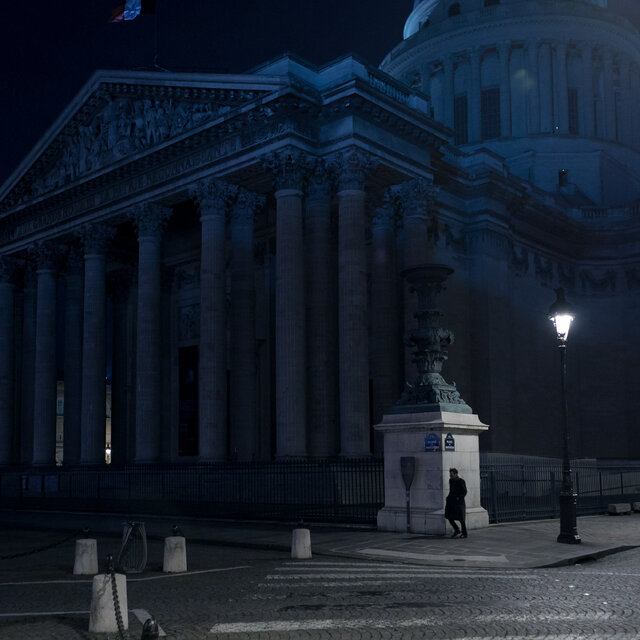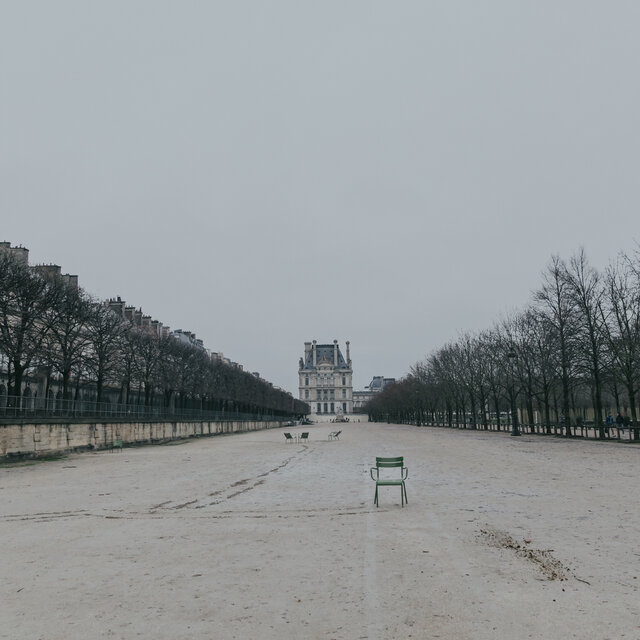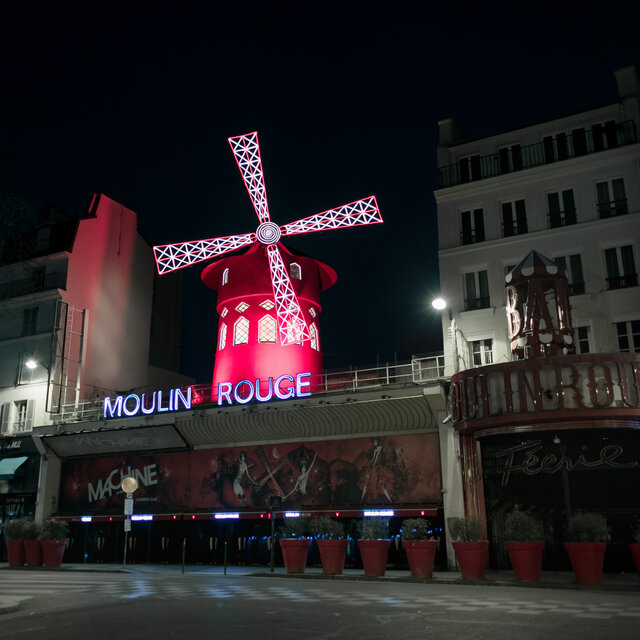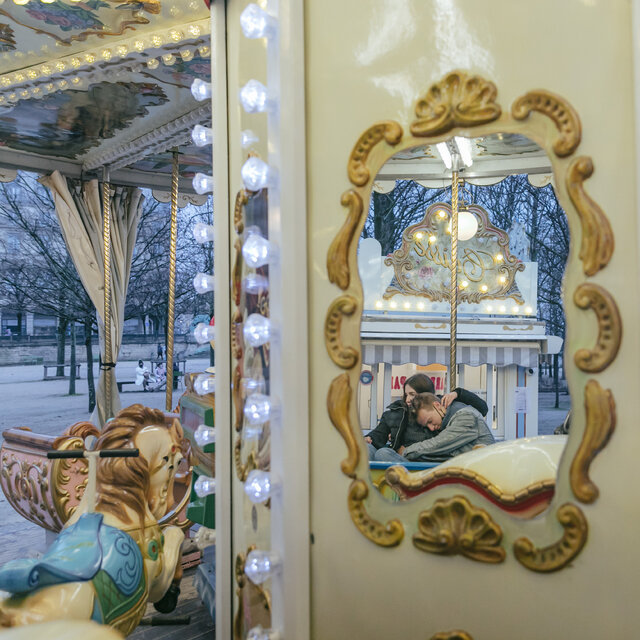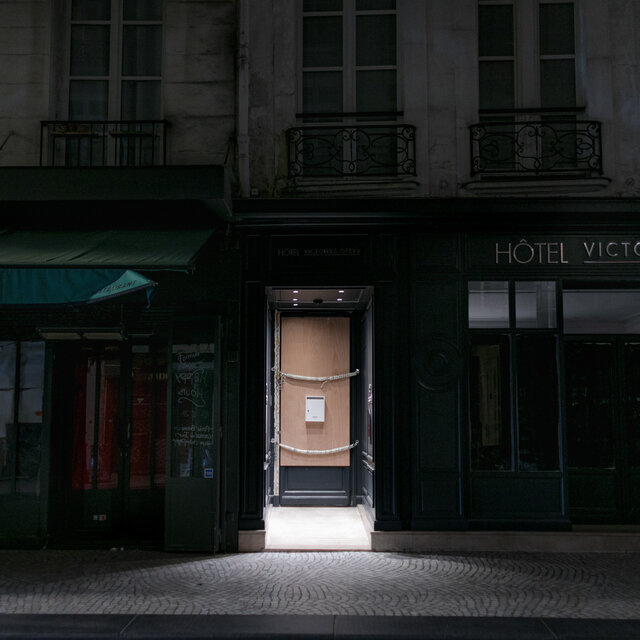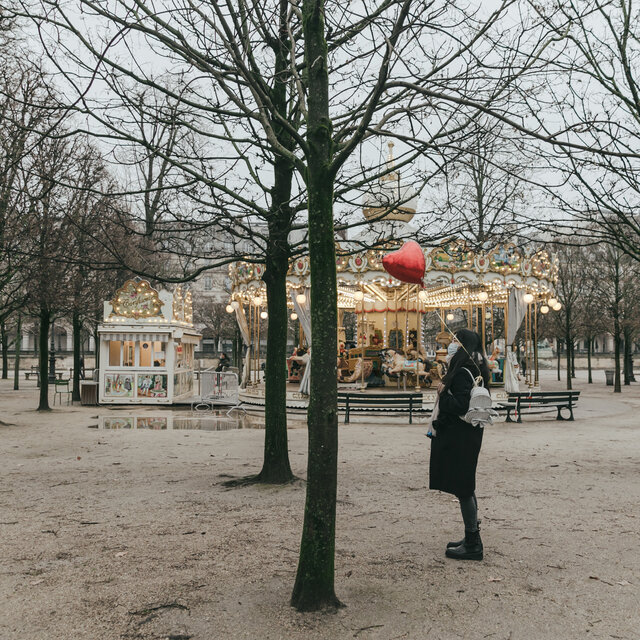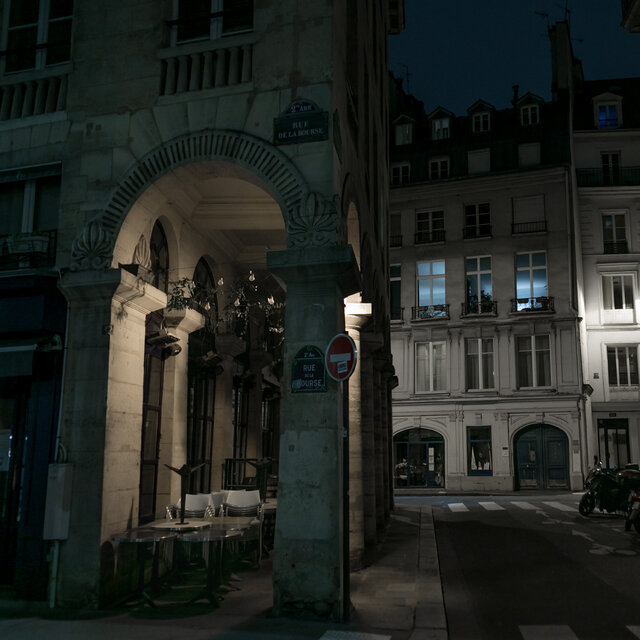transcript
transcript
New York City Postpones Vaccine Appointments Ahead of Storm
Mayor Bill de Blasio said the city would postpone Covid-19 vaccinations scheduled for Monday and suspend in-person learning for the day after winter storm conditions were forecast for the area.
-
“For Monday, we are not going to have in-person school. We will pivot to remote learning for all our students. So no school in-person on Monday — canceled now. We will have an update tomorrow about Tuesday. Right now we do not have a decision for Tuesday yet. We have to see more about how this storm develops. Vaccine sites, and again, we want to get everyone vaccinated. We’re going be talking about that later, There’s such urgency, But there’s also going to be tremendous difficulty and danger getting around Monday. Last thing we want to do is urge our seniors to come out in the middle of a storm like this. It doesn’t make sense. So we’re rescheduling Monday appointments for vaccine. They’ll be postponed. The Monday vaccine appointments will be postponed. We’ll get them done as quickly as humanly possible. But it’s just not going to be safe out there on Monday. The Tuesday vaccine appointments, right now we’re hoping to get those on time. We’re going to have more information on that as we go along.”
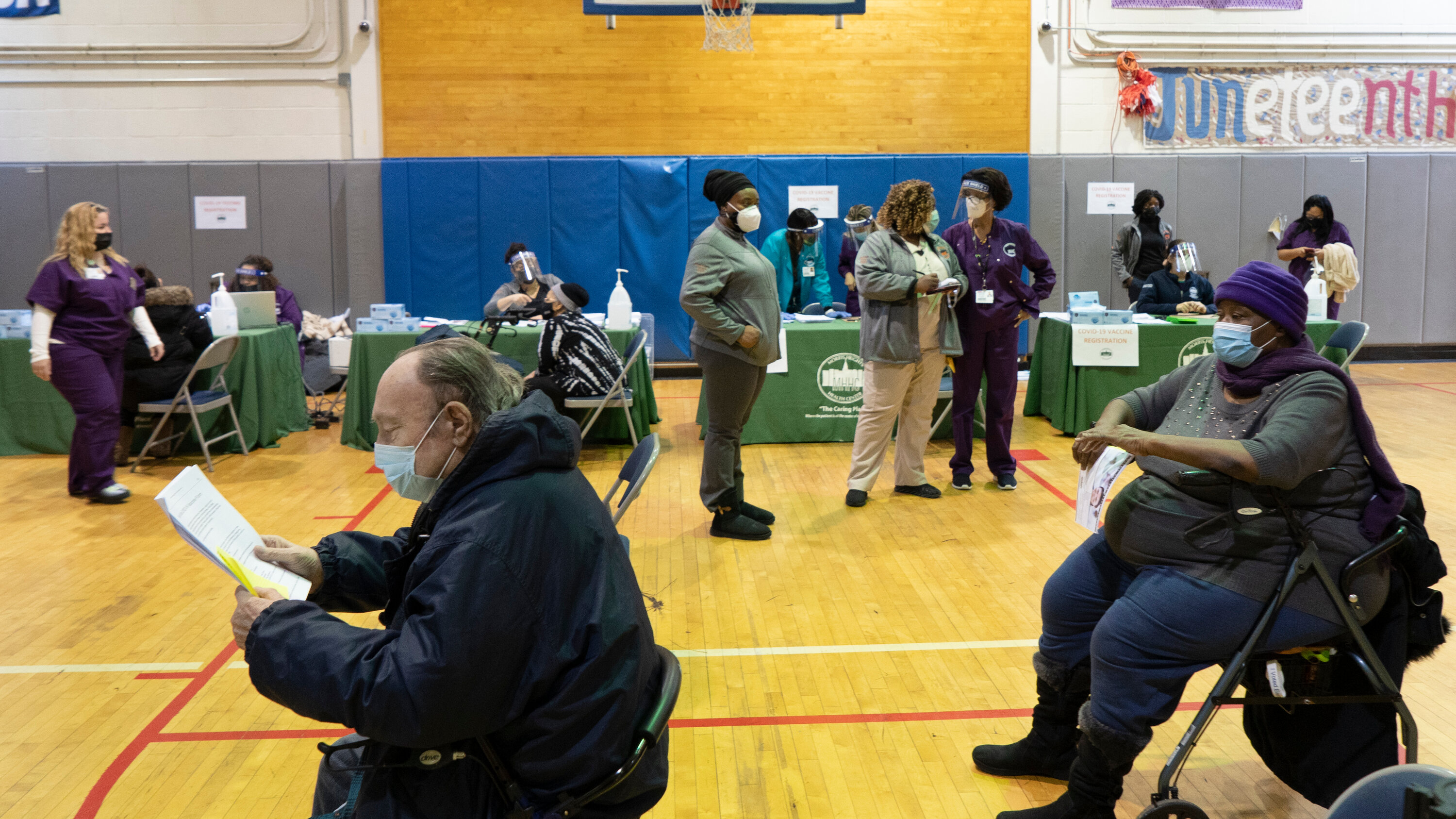
Vaccine sites in the New York metro area are closed Monday because of a looming winter storm that is expected to dump up to 16 inches of snow on the region.
A powerful winter storm sweeping up the Atlantic Coast was also disrupting vaccinations in Washington, D.C., Philadelphia, New Jersey and elsewhere.
At a news conference on Sunday, Mayor Bill de Blasio said he did not want older New Yorkers on the road traveling to vaccine appointments, warning of blizzard-like conditions with gusty winds. Vaccinations scheduled for Tuesday in New York City have not been canceled, for now, Mr. de Blasio said.
The storm will temporarily derail a vaccine rollout in New York City that has been plagued with inadequate supply, buggy sign-up systems and confusion over the state’s strict eligibility guidelines. The vaccine is available to residents 65 and older as well as a wide range of workers designated “essential.”
About 800,000 doses have been administered so far in the city, Mr. de Blasio said.
Vaccine appointments at several sites in the region — the Javits Center in Manhattan, the Aqueduct Racetrack in Queens, a drive-through site at Jones Beach in Long Island, SUNY Stony Brook and the Westchester County Center — will be rescheduled for this week, according to a statement from Melissa DeRosa, a top aide to Gov. Andrew Cuomo. “We ask all New Yorkers to monitor the weather and stay off the roads tomorrow so our crews and first responders can safely do their jobs,” she said.
In the Philadelphia area, city-run testing and vaccine sites will be closed on Monday. Rhode Island, Connecticut, New Jersey and parts of the D.C., Maryland and Virginia areas were following suit. Some areas away from the center of the storm were expected to remain open for vaccinations on Monday, including parts of upstate New York and Massachusetts. Some vaccination sites in the Boston area said they would close early on Monday and postpone some Tuesday appointments.
Storms in other regions have sometimes prompted health officials to improvise. In Oregon, a group of officials transporting vaccines that were near their expiration last week offered them to drivers stuck on the side of the road.
The vaccine effort in New York City has been hampered by other issues besides the weather, including distribution snags and stark racial disparities, with Black and Latino residents getting a disproportionately small share of the doses given so far, according to Mr. de Blasio.
The city’s demographic data was incomplete, but the numbers so far were striking: Of nearly 300,000 city residents who received one dose and whose race was recorded, about 48 percent were white, 15 percent were Latino, 15 percent were Asian and 11 percent were Black. The city’s population is roughly 29 percent Latino and 24 percent Black.
An attempt to bring more vaccination kits this week to underserved communities in Brooklyn and the Bronx was also pushed back, with six pop-up sites in the two boroughs rescheduled to open on Wednesday, Ms. DeRosa said.
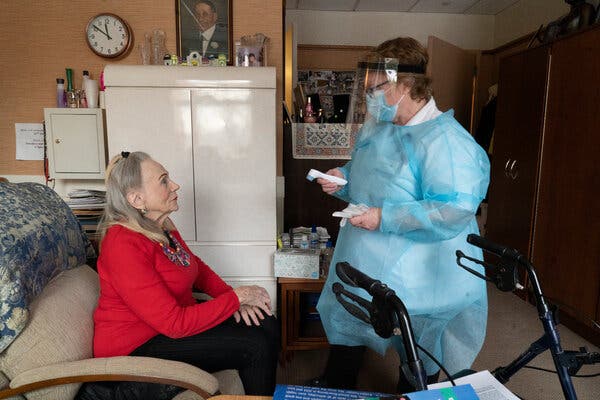
Amid a sometimes chaotic rollout of vaccines across the United States, health experts say a glimmer of good news has emerged: Recent reports of coronavirus cases in nursing homes have declined for the past four weeks, according to federal data.
The country recorded 17,584 cases in nursing homes during the week ending on Jan. 17, according to the federal data released by the Centers for Medicare and Medicaid Services. A month earlier, during the week ending on Dec. 20, more than 32,500 cases were reported.
In part, the development reflects a downward trend in new cases across the country, health experts said. Coronavirus cases in nursing homes are driven by infections in the rest of the community, said Dr. Ashish K. Jha, dean of the Brown University School of Public Health, so one can expect to see cases at long-term care facilities drop when the numbers are declining elsewhere.
But the decline in cases in nursing homes is more pronounced than it is nationally, and it also began earlier, Dr. Jha said. Residents in nursing homes have been prioritized as among the first groups to get the vaccine. “That combination really does make me think this is not just broad national patterns, but that vaccines probably are playing a role,” Dr. Jha said. “I’m optimistic, this is good.” Data from the Centers for Disease Control and Prevention shows that as of Saturday, more than 3.5 million shots have now been administered in long-term care facilities, including to workers and residents.
Still, a slower-than-expected vaccine rollout in nursing homes has been deeply frustrating, Dr. Jha said. Efforts to efficiently give shots to all nursing home residents should be a top priority, he said, adding, “Once that’s in, then we should feel really confident that these declines will continue and we will not see a spike back up, even if we see one in the national picture.”
Nursing homes have been devastated by the virus. Although 5 percent of the country’s cases have occurred in long-term care facilities, deaths related to Covid-19 in these settings have accounted for about 36 percent of deaths from the virus in the country, according to a New York Times database.
In New York, new reports of cases among residents in nursing homes that belong to the New York State Health Facilities Association — which includes 425 skilled nursing homes and assisted living facilities — have been steadily declining since the first and second week of January, said Stephen Hanse, chief executive of the association.
“Throughout the state, providers really saw the cases reducing, residents stabilizing,” he said, adding that it’s too early to tell if the drop is directly linked to the number of vaccine doses being administered. A large majority of residents in the association’s facilities — at least 80 percent — have now received their second dose of the vaccine, Mr. Hanse said. Nursing home administrators and directors “really see the vaccine as the light at the end of the tunnel,” he said.

President Biden will meet with Republican senators this week after the lawmakers wrote to Mr. Biden on Sunday, outlining a framework for coronavirus relief legislation and pushing for Mr. Biden to compromise, Jen Psaki, the White House press secretary, said in a statement.
The 10 senators, led by Susan Collins of Maine, proposed a framework that includes some of the provisions in Mr. Biden’s $1.9 trillion plan but would curtail others, including eligibility for direct payments and unemployment aid. It would include $160 billion for vaccine distribution and development, coronavirus testing and the production of personal protective equipment, along with relief for schools, small businesses and “more targeted assistance” for individuals.
“Our proposal reflects many of your stated priorities, and with your support, we believe that this plan could be approved quickly by Congress with bipartisan support,” the senators wrote.
Mr. Biden later called Ms. Collins and invited her and other signers “to come to the White House early this week for a full exchange of views,” Ms. Psaki said in a statement late Sunday. The president also spoke to Speaker Nancy Pelosi of California and Senator Chuck Schumer of New York, the majority leader.
But in her statement, Ms. Psaki said that Mr. Biden’s $1.9 trillion plan “is badly needed.”
“As leading economists have said, the danger now is not in doing too much; it is in doing too little,” she said.
The Republican letter came as Democrats were preparing to bypass the need for G.O.P. support in order to deliver a sweeping relief package.
One signer, Senator Bill Cassidy of Louisiana, said on “Fox News Sunday” that he expected the Republican package to total about $600 billion, roughly one-third of what Mr. Biden has proposed.
The group, which also includes Mitt Romney of Utah, Michael Rounds of South Dakota, Lisa Murkowski of Alaska and Shelley Moore Capito of West Virginia, is expected to release additional details of its proposal on Monday.
Another member of the group, Rob Portman of Ohio, called for a smaller stimulus package that would limit direct payments so that they would not go to Americans earning more than $50,000 a year or to families with a combined income exceeding $100,000.
“Let’s focus on those who are struggling,” Mr. Portman said on the CNN program “State of the Union.”
To pass a package through the regular legislative process, Mr. Biden would need 60 votes in the Senate. Adding the 10 Republicans who signed the letter to the 50 Democrats in the chamber would just reach that threshold. But substantially shrinking the size of the package would probably cost Mr. Biden Democratic support in both the Senate and the House of Representatives.
Mr. Biden and top Democrats have said they want Republican support for a new relief bill. But with several Republicans already balking at passing a sweeping package, Democrats are preparing to pass a bill on their own using budget reconciliation, a legislative process that is more complicated but requires only a simple majority in the Senate.
Mr. Portman warned against going that route, saying on CNN that doing so would “set President Biden down a path of partisanship that will poison the well.”
The 10 Republicans’ letter appeared to do little on Sunday to change the Democrats’ plans, which begin with the introduction of a budget resolution later this week. Administration officials signaled on Sunday that they intended to resist calls to reduce the scale of the relief package.
Jared Bernstein, a member of the White House Council of Economic Advisers, said on “Fox News Sunday” that speed in approving a package was more important to most Americans than how Congress goes about it.
“President Biden has consistently said he will negotiate with those on the other side of the aisle about getting this plan out as quickly as possible,” Mr. Bernstein said.
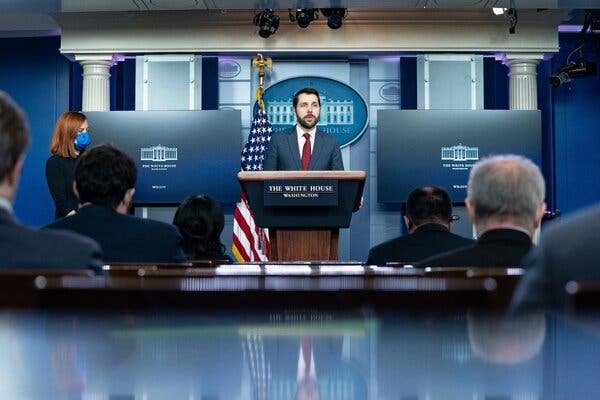
President Biden remains willing to negotiate with Republicans on an economic relief package, but it must pass quickly in order to arrest the Covid-19 pandemic and help keep millions of Americans from going hungry, two top White House economic aides said on Sunday morning.
Brian Deese, the director of the White House’s National Economic Council, said on the CNN program “State of the Union” that the cost of failing to provide enough help for the economy would be far greater than the cost of the $1.9 trillion package Mr. Biden’s administration has proposed.
“We just lived through the worst economic year since the demobilization in the wake of World War II,” Mr. Deese said. “We’re in a unique crisis, and the elements of this plan really were designed, and are designed, to take on that crisis head-on.”
Jared Bernstein, a member of the White House Council of Economic Advisers, said on “Fox News Sunday” that Americans care more about how quickly they will get relief than about the process of passing a relief bill.
“President Biden has consistently said he will negotiate with those on the other side of the aisle about getting this plan out as quickly as possible,” Mr. Bernstein said.
Shortly before Mr. Deese and Mr. Bernstein appeared on television, 10 Republican senators released a letter to Mr. Biden, calling for talks on a smaller economic relief package than the president has proposed. The senators’ plan, which they said would be laid out in greater detail on Monday, would scale back assistance for the unemployed and eligibility for direct payments of $1,400, compared with Mr. Biden’s plan.
Mr. Deese and Mr. Bernstein each sidestepped questions about the Republican letter, which Mr. Bernstein said he had seen for the first time only a few minutes before his interview.
Mr. Deese suggested that the administration might be willing to consider more narrowly targeting the $1,400 direct payments. “We’re open to looking at how to make the entire package effective at achieving its objective,” he said, “including providing support to families with children.”

The scattered reports from around the country can play like a cruel irony: Someone tests positive for the coronavirus even though they have already received one or both doses of a Covid-19 vaccine.
Notable examples
It’s happened to at least three members of Congress recently:
But it’s been reported in people in other walks of life too, including Rick Pitino, a Hall of Fame basketball coach, and a nurse in California.
How can that happen?
Experts say cases like these are not surprising and do not indicate that there was something wrong with the vaccines or how they were administered. Here is why.
-
Vaccines don’t work instantly. It takes a few weeks for the body to build up immunity after receiving a dose. And the vaccines now in use in the U.S., from Pfizer-BioNTech and Moderna, both require a second shot a few weeks after the first to reach full effectiveness.
-
Nor do they work retroactively. You can already be infected and not know it when you get the vaccine — even if you recently tested negative. That infection can continue to develop after you get the shot but before its protection fully takes hold, and then show up in a positive test result.
-
The vaccines prevent illness, but maybe not infection. Covid vaccines are being authorized based on how well they keep you from getting sick, needing hospitalization and dying. Scientists don’t know yet how effective the vaccines are at preventing the coronavirus from infecting you to begin with, or at keeping you from passing it on to others. (That’s why vaccinated people should keep wearing masks and maintaining social distance.)
-
Even the best vaccines aren’t perfect. The efficacy rates for Pfizer-BioNTech and Moderna vaccines are extremely high, but they are not 100 percent. With the virus still spreading out of control in the U.S., some of the millions of recently vaccinated people were bound to get infected in any case.
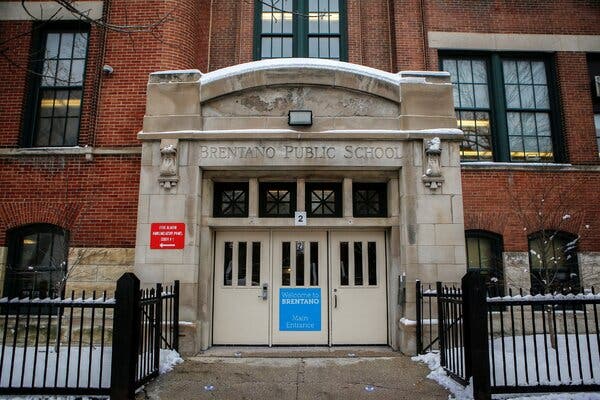
Chicago edged closer to a teacher strike on Sunday over the district’s plan to reopen classrooms for kindergarten through eighth grade students for the first time since March.
Tens of thousands of students had been expected to return to school buildings on Monday. But the teachers union, which argues that the reopening plan is unsafe, has directed all of its members to refuse to report to schools until the two sides reach an agreement and has threatened to strike if the district retaliates against teachers for staying home.
Mayor Lori Lightfoot and the chief executive of the school system, Janice K. Jackson, said on Sunday night that all teachers in the classrooms that are reopening who have not been granted accommodations to work remotely were expected to come to school on Monday; those who did not would be locked out of the district’s virtual teaching system at the end of the day, and would not be paid until they reported in-person.
Meanwhile, the school district said it was delaying the start of in-person instruction by a day, telling parents that they should plan to bring their students to school on Tuesday. Prekindergarten students and some special education students, who had been back in school in person from Jan. 11 until last Wednesday, when the union directed all of its members to stay home, will also continue to learn remotely on Monday.
Mayor Lightfoot said that the district and the union had held some 70 meetings so far on the reopening plan, including meeting nearly every day over the last two weeks. She said the sides had made some progress on Saturday but that the union had not shown up for a planned negotiating session on Sunday, and she urged them to come back to the table.
The union reiterated on Sunday that it wants teachers not to be required to go back to schools until they have been vaccinated; the district has said that teachers will begin being vaccinated in mid-February. It is also pushing for the district to allow teachers who have family members with high-risk conditions to work from home, and to set a metric of cases or positivity rate above which schools will close or remain closed.
The union has argued that by reopening school buildings the district is catering to white families, who have opted for in-person learning in higher numbers, and neglecting Black and Latino families, most of whom have chosen to continue having their children learn remotely.
On Sunday, the union’s vice president, Stacy Davis Gates, said that the district would harm those families if it locks teachers out of the virtual learning system.

Tom Moore, 100, a decorated British Army veteran who captured the attention of the British public in the early months of the coronavirus pandemic by raising $40 million for the National Health Service, was hospitalized with the virus on Sunday, his daughter said.
Mr. Moore had been treated for pneumonia in recent weeks and tested positive for the coronavirus last week, Hannah Ingram-Moore said in a statement on Twitter. He was taken to a hospital because he needed help with his breathing, she said, but he was not in the intensive care unit.
Mr. Moore became a national hero after he completed 100 laps of an 82-foot walk on the brick patio next to his garden in Marston Moretaine, a quiet village north of London, to raise money for the N.H.S.
The laps, which Mr. Moore completed 50 meters at a time while gripping his walker and wearing a blazer adorned with military medals, quickly caught the attention of Britain’s public and its news media, which nicknamed him Captain Tom. He raised 32.8 million pounds, or $40 million, through an online charity. Prince William, who contributed an undisclosed sum, called him a “one-man fund-raising machine.”
News of Mr. Moore’s illness came days after Britain surpassed 100,000 deaths from the coronavirus. The country’s response to the pandemic has been filled with delays, reversals and mixed messages, most recently in the struggle to contain a fast-spreading variant of the virus.
Ms. Ingram-Moore did not immediately respond to a request for comment. A spokeswoman for Mr. Moore’s family told the BBC that he had not yet been vaccinated because of the medication he was taking for his pneumonia.
In September, Mr. Moore published a best-selling autobiography, “Tomorrow Will Be a Good Day,” and at one point, he had the No. 1 song in Britain with a version of the Rodgers & Hammerstein standard “You’ll Never Walk Alone,” which he recorded with the English singer Michael Ball and the N.H.S. Voices of Care Choir. Queen Elizabeth II knighted Mr. Moore in July.
In an interview with The New York Times last year, Mr. Moore drew comparisons between the beleaguered health workers fighting the coronavirus and the soldiers who won World War II.
“At that time, the people my age, we were fighting on the front line and the general public was standing behind us,” Mr. Moore said. “In this instance, the doctors and nurses and all the medical people, they’re the front line. It’s up to my generation to back them up, just as we were backed up.”
FACT CHECK

On Jan. 5, Hank Aaron, the legendary home run hitter, posted on Twitter that he had been vaccinated for the coronavirus at the Morehouse School of Medicine, along with other prominent civil rights figures in Atlanta who were 75 or older and thus part of the group at the highest priority to be inoculated.
“I hope you do the same!” he wrote.
Seventeen days later, Mr. Aaron died at the age of 86.
Now, anti-vaccine activists, including Robert F. Kennedy Jr., a prominent vaccine skeptic, are seizing on his death to suggest — without evidence — that there might be a link.
“That was a pure coincidence,” countered Dr. Louis W. Sullivan, the founding dean of the Morehouse medical school and secretary of health and human services in the George H.W. Bush administration, who was vaccinated along with Mr. Aaron. He told the Atlanta station WSB-TV, “It is though, if you might say, Hank was in a car before the day he died, and we try and attribute his death to being in a car.”
The Fulton County medical examiner has also said there was nothing to suggest that Mr. Aaron had an allergic or anaphylactic reaction related to the vaccine.
Still, Mr. Aaron’s death has gotten caught up in a swirl of misinformation and misunderstanding surrounding the coronavirus and society’s efforts to fight it. Skepticism about the vaccines has emerged as one of the latest forms of resistance that health officials have confronted throughout the pandemic, as critics have flouted social distancing rules and bristled at covering their faces with masks.
Demonstrators forced the authorities in Los Angeles to close the entrance to Dodger Stadium, one of the largest vaccination sites in the country, for an hour on Saturday. About 50 protesters had gathered there, with some holding posters that said “99.96% Survival Rate” and “End the Lockdown.”
Health officials say that so far, with more than 25 million doses administered in the United States, the two vaccines already authorized for use appear to be quite safe. There have been a few severe allergic reactions, including anaphylaxis, but they are treatable and considered rare, and no deaths have been reported from them. The rates at which anaphylaxis has occurred so far — five cases in every million doses of the vaccine by Pfizer and BioNTech, and 2.8 cases per million for the vaccine by Moderna — are in line with what happens with other widely used vaccines.
At a meeting on Wednesday of expert advisers to the Centers for Disease Control and Prevention, Dr. Tom Shimabukuro of the C.D.C. said, “Over all, the safety profiles of the Covid-19 vaccines are reassuring and consistent with that observed in the preauthorization clinical trials.”
He said the federal government had “implemented the most intense and comprehensive vaccine safety monitoring program in history.”
Even so, anti-vaccine activists have sought to undermine the public’s confidence in the vaccines, using social media to spread unfounded accounts of people dying or suffering drastic side effects.
Polls have shown that public confidence in the vaccines has solidified generally in recent months, but confidence among African-Americans is running lower than among other demographic groups, even though the virus has swept through that community with a punishing fury.
That is why the Morehouse School of Medicine assembled pioneering civil rights leaders like Mr. Aaron and Andrew Young, the former United Nations ambassador, to get vaccinated and lead by example.
“They marched to the polls to secure our rights,” Valerie Montgomery Rice, the dean and president of the medical school, said in a statement. “And now, they are rolling up their sleeves to save lives.”

Andrew Brooks, a research professor at Rutgers University who developed the first saliva test for the coronavirus, died on Jan. 23 in Manhattan. He was 51.
The cause was a heart attack, his sister, Janet Green, said.
In April 2020, when coronavirus tests were scarce and lines to get them were long, Dr. Brooks made worldwide news when the Food and Drug Administration gave emergency approval to his technique, which promised to radically increase the speed and safety of the testing process.
“Instead of having a naso- or oropharyngeal swab that’s placed in your nose or the back of your throat, you simply have to spit in a tube,” he told Bill Hemmer of Fox News, adding, “It doesn’t require a health care worker to collect it, six inches away from an infected person.”
In the 10 months since Dr. Brooks received approval, health care workers have performed more than four million tests using his approach, and it remains one of the most reliable means of determining whether someone has the coronavirus.
In a statement after Dr. Brooks’s death, Gov. Phil Murphy of New Jersey called him “one of the state’s unsung heroes” who “undoubtedly saved lives.”
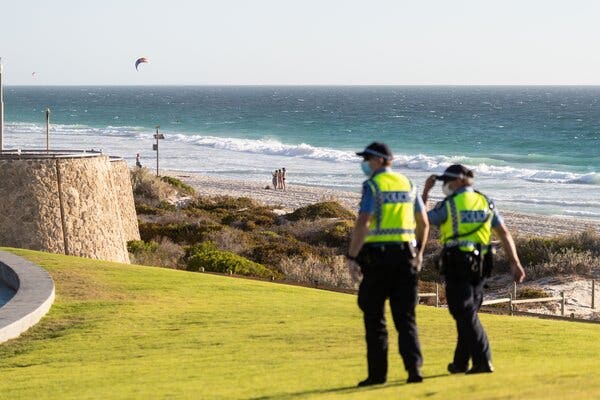
Australian officials on Sunday imposed a five-day lockdown on the city of Perth, the capital of Western Australia, after the state reported a single case of community transmission of the coronavirus, the first in almost 10 months.
Under the new restrictions, which last until Friday evening, about two million people in the city and surrounding areas can leave home only for essential reasons like exercise, medical needs and shopping for groceries. Restaurants, bars and gyms will shut and mask-wearing will be compulsory in public. Schools, which were scheduled to reopen this week after the term break, will remain closed.
“I know for many Western Australians, this is going to come as a shock,” Mark McGowan, the state’s premier, said at a news conference announcing the measures. The state has “crushed” the outbreak before, he said, but “we cannot forget how quickly this virus can spread, nor the devastation it can cause.”
The infected patient, a security guard at a quarantine hotel, developed symptoms on Thursday, Mr. McGowan said. One traveler at the hotel had tested positive for the more contagious virus variant that was first spotted in Britain.
Australia has been praised for its comparative success in handling the pandemic, reporting a total of 28,810 cases and 909 deaths, far fewer relative to its size than most other developed countries. It has moved aggressively to clamp down on new outbreaks, and has largely banned its citizens from leaving the country. New cases have been discovered mainly in returning travelers, who are strictly quarantined in hotels.
The city of Brisbane quickly imposed a three-day lockdown earlier this month after a cleaner who worked at a quarantine hotel there tested positive.
The country has reopened a travel bubble with neighboring New Zealand and has begun to allow domestic travel from state to state, though officials have not hesitated to close state borders against emerging outbreaks.
Paris is gone for now, its lifeblood cut off by the closure of all restaurants, its nights silenced by a 6 p.m. curfew aimed at eliminating the national pastime of the aperitif, its cafe bonhomie lost to domestic morosity. Blight has taken the City of Light.
Taboos fall. People eat sandwiches in the drizzle on city benches. They yield — oh, the horror! — to takeout in the form of “le click-and-collect.” They dine earlier, an abominable Americanization. They contemplate with resignation the chalk-on-blackboard offerings of long-shuttered restaurants still promising a veal blanquette or a boeuf bourguignon. These menus are fossils from the pre-pandemic world.
Gone the museums, gone the tourist-filled riverboats plying the Seine, gone the sidewalk terraces offering their pleasures at dusk, gone the movie theaters, gone the casual delights of wandering and the raucous banter of the most northern of southern cities. In their place, a gray sadness has settled over the city like fog.
Paris is far from alone in its deprivations. The pandemic has, in some ways, imposed conditions of war in time of peace. It, too, will end.
But until then, “We’ll always have Paris,” and in these photographs by Andrea Mantovani for The New York Times, the City of Light proves it is worth soldiering through for in the fog.

As frustration mounts in Canada over lockdowns and the glacial pace of vaccinations, a consortium of some of the country’s largest companies has begun a rapid testing program with the aim of protecting their 350,000 employees.
The program is believed to be the first of its kind among the Group of 7 industrialized nations, and has already attracted the attention of the Biden administration.
The 12 companies, including Canada’s biggest airline and grocery chain, have worked together for four months, creating a 400-page operating manual on how to run rapid antigen tests in various work settings. They began piloting the tests in their workplaces this month, and expect to expand the program to 1,200 small and medium-size businesses.
They also plan to share their test results with the government health authorities, greatly raising test counts in the country and providing an informal study of the virus’s spread among asymptomatic people.
The companies in the consortium were brought together in the spring by Ajay Agrawal, the founder of the University of Toronto’s Creative Destruction Lab, which helps science and technology start-ups. They were inspired by the most Canadian of muses: Margaret Atwood, the author.
“How soon can we have a cheap, buy-it-at-the-drugstore, self-administered test?” Ms. Atwood asked during a virtual meeting last May of business leaders and others tasked with brainstorming ideas for economic recovery during the pandemic.
The problem, the group posited, was the “information gap” — since there was no way to tell who might be an asymptomatic carrier, everyone was treated as a potential threat.
Ms. Atwood envisioned something like a home pregnancy test.
“That would be a game changer,” she said.
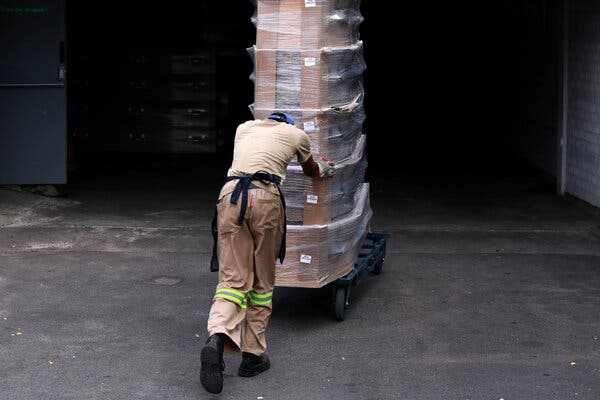
As new variants like the one discovered in South Africa migrate to more countries — including the United States — it is becoming ever clearer that the tragedy for poorer countries could become a tragedy for every country. The more the virus spreads, and the longer it takes to vaccinate people, the greater chance it has to continue to mutate in ways that put the whole world at risk.
Recent studies suggest that at least four vaccines that are effective at preventing infection with the original virus did not perform as well against the variant found in South Africa. That variant is also more infectious — as is another one, discovered in Britain — and it is now estimated to make up 90 percent of all cases in South Africa, according to data compiled by researchers. It has turned up in dozens of other countries.
Inoculation prompts the immune system to make antibodies to the virus, but as mutations change its shape, the virus can become more resistant to those antibodies. In the worst case, failing to stop the spread of the virus globally would allow more mutations that could make existing vaccines less effective, leaving even inoculated populations vulnerable.
“This idea that no one is safe until everyone is safe is not just an adage, it is really true,” said Andrea Taylor, the assistant director at Duke Global Health Innovation Center.
Even in the most optimistic scenarios, Ms. Taylor said, at the current pace of production, there will not be enough vaccines for true global coverage until 2023. The current rollout plans across Africa are expected to vaccinate only 20 percent to 35 percent of the population this year if everything goes right.
And while some wealthy countries have secured enough vaccine to cover their populations multiple times, South Africa has secured just 22.5 million doses for its 60 million people, and many nations lag even farther behind.
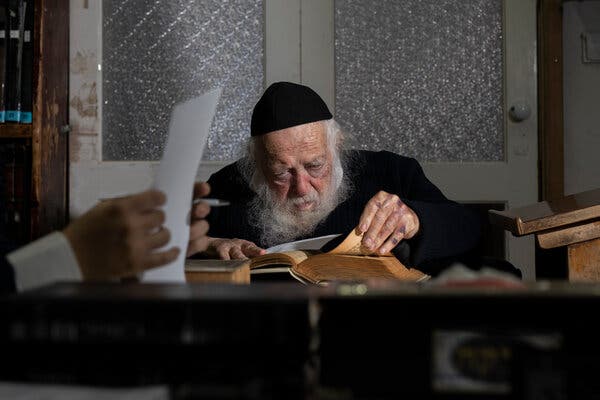
BNEI BRAK, Israel — Rabbi Chaim Kanievsky, 93, can’t use a phone. He rarely leaves his house. His family says he has never successfully made a cup of tea. His closest aides think he doesn’t know the name of Israel’s prime minister. He studies the Torah for, give or take, 17 hours a day.
Yet despite his seeming detachment from worldly life, Rabbi Kanievsky has become one of the most consequential and controversial people in Israel today.
The spiritual leader of hundreds of thousands of ultra-Orthodox Jews, Rabbi Kanievsky has landed at the center of tensions over the coronavirus between the Israeli mainstream and its growing ultra-Orthodox minority.
Throughout the pandemic, the authorities have clashed with ultra-Orthodox Jews over their resistance to antivirus safety protocols, particularly their early refusal to close schools or to limit crowds at religious events. Similar conflicts have arisen in the New York area.
Rabbi Kanievsky, issuing pronouncements from a book-filled study in his cramped apartment in an ultra-Orthodox suburb of Tel Aviv, has often been at the fore of that resistance. Twice, during the first and second waves of the pandemic in Israel, he initially rejected state-imposed safety restrictions and refused to order his followers to close their yeshivas, the independent religious schools where students gather in close quarters to study Jewish Scripture.
If anything, he said, the pandemic made prayer and study even more essential.
Both times he eventually relented, and it was not clear whether his stances did as much to accelerate the spread of the virus as his critics said. But the damage was done.
Many public health experts say that ultra-Orthodox Jews — who account for about 12 percent of the Israeli population but 28 percent of the country’s coronavirus cases, according to Israeli government statistics — have undermined the national effort against the pandemic. The reaction to the outsized role of the ultra-Orthodox has been fierce, and much of it has centered on Rabbi Kanievsky.
Those We’ve Lost

This obituary is part of a series about people who have died in the coronavirus pandemic. Read about others here.
As a boy, Isidore Torres owned two pairs of pants: one for school, one for hoeing sugar beet fields outside Bay City, Mich., alongside his mother and siblings.
“If you could hold a hoe, you were out there working from sunrise until 5 o’clock in the afternoon,” an older brother, Abel Torres, said.
For years, the family had shuttled between Michigan and Texas looking for migrant work, eventually settling in Bay City so the children could receive a steady education.
Mr. Torres never forgot his humble roots, even as he became the first Hispanic judge in the Wayne County court system and served on state benches for more than a quarter-century. A prominent figure among Michigan Latinos, known for an endearing smile and a love of coffee, he had the ear of mayors, governors and congressmen as he lobbied for more minority representation in the legal system.
Mr. Torres died on Jan. 12 at Beaumont Hospital in Troy, Mich. He was 73. The cause was Covid-19, his family said. He also had central nervous system lymphoma.
“My father always had to fight for the life that he wanted,” said his son, Felipe Barboza Torres, a Wayne County prosecutor. “No one ever told him that he would be a great lawyer. They told him he wouldn’t be able to be a lawyer because he was brown.”
